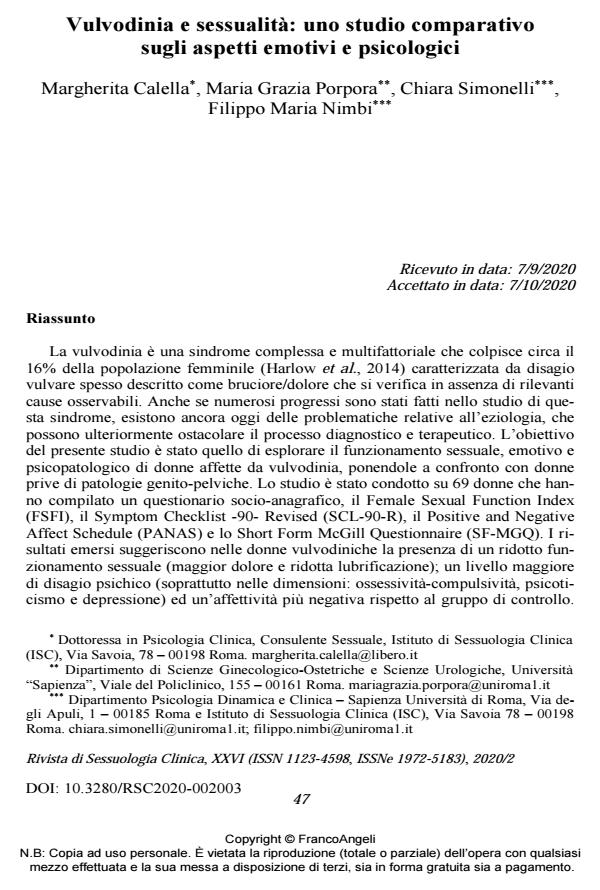Vulvodynia and sexuality: a comparative study on emotional and psychological aspects
Journal title RIVISTA DI SESSUOLOGIA CLINICA
Author/s Margherita Calella, Maria Grazia Porpora, Chiara Simonelli, Filippo Maria Nimbi
Publishing Year 2020 Issue 2020/2
Language Italian Pages 18 P. 47-64 File size 267 KB
DOI 10.3280/RSC2020-002003
DOI is like a bar code for intellectual property: to have more infomation
click here
Below, you can see the article first page
If you want to buy this article in PDF format, you can do it, following the instructions to buy download credits

FrancoAngeli is member of Publishers International Linking Association, Inc (PILA), a not-for-profit association which run the CrossRef service enabling links to and from online scholarly content.
Vulvodynia is a complex, multifactorial and difficult to diagnose syndrome that affects approximately 16% of the female population (Harlow et al., 2014). Affected women highlight the presence of vulvar discomfort often described as burning / pain that occurs in the absence of relevant observable causes. Over time, different of definitions have been attributed to this syndrome due to the difficul-ties encountered by the scientific community in understanding the true nature of the pathology. At present, the definition given by the Consensus Terminology and Classification of Persistent Vulvar Pain and Vulvodynia, in April 2015, seems to be the most valid. It defines vulvodynia as "vulvar pain lasting at least three months with no clear identifiable cause but which may have potential associated factors. Among them are mentioned various neurological, inflammatory, genetic, muscular and psychological factors that can coexist and overlap in the same patient, play-ing a fundamental role in the pain experience (Bornstein et al., 2016). Although numerous advances have been made in the study of this syndrome, there are still problems related to its etiology, which can further hinder the diagnostic and therapeutic process. In fact, the role played by psychological factors in the development and maintenance of vulvodynia is not yet fully understood. One wonders if the psychic factors present in these women are triggers or if they play an important role only in maintaining the syndrome. What is known for sure is that vulvodynia produces a significant negative impact on the quality of life of these women both on a sexual, that psychic and relational level. In fact, there are many women who present catastrophic thoughts in reference to their painful condition, fear of pain with consequent dysfunctional behaviors aimed at avoiding any sexual activity and hypervigilance understood as a continuous monitoring of genital sensations (Alappattu et al., 2017; Boerner, Rosen, 2015). Furthermore, these are often wom-en who may question their sense of femininity (Mallie, Bergeron e Lambert, 2014) and develop a negative attribution style due to repeated sexual experiences that do not meet expected expectations. It follows that the negative meaning in refer-ence to one’s sexual life, generated by the painful experience, could cause a strong distress in the couple and favor the onset of anxious and depressive states present in each member of the relationship (Paquet et al., 2018). What has been said makes reflect on the importance in considering vulvodynia through a bio-psycho-social perspective that takes into account the interaction between the various biological, psychological and social factors capable of simultaneously increasing the development and maintenance of this syndrome. Therefore, are the evaluation of personal and relational experiences linked to the sexual symptom that these wom-en exhibit is also of fundamental importance (Tripodi et al., 2016). The target of this study is to explore the sexual, emotional and psychopathological functioning of women with vulvodynia, comparing them with women without genito-pelvic diseases. The study was conducted on 69 women who completed a socio-demographic questionnaire, the Female Sexual Function Index (FSFI), the Symp-tom Checklist -90- Revised (SCL-90-R), the Positive and Negative Affect Schedule (PANAS) and the Short Form McGill Questionnaire (SF-MGQ). The results suggest the presence of a reduced sexual functioning (greater pain and reduced lubrica-tion) in women affected by vulvodynia; a higher level of mental distress (especial-ly in severity: obsessiveness-compulsiveness, psychoticism and depression) and a more negative affectivity than in the control group. Future investigations could contribute to a better understanding of the impact this syndrome produces on the sexual wellness and quality of life of women who are affected by it, directing specialists towards forms of multidisciplinary intervention, which according to the bio-psycho-social model, might be more appropriate and effective
Keywords: Vulvodynia, genital pain, sexual functioning, psychopathological func-tioning, emotional aspects, biopsychosocial model.
Margherita Calella, Maria Grazia Porpora, Chiara Simonelli, Filippo Maria Nimbi, Vulvodinia e sessualità: uno studio comparativo sugli aspetti emotivi e psicologici in "RIVISTA DI SESSUOLOGIA CLINICA" 2/2020, pp 47-64, DOI: 10.3280/RSC2020-002003